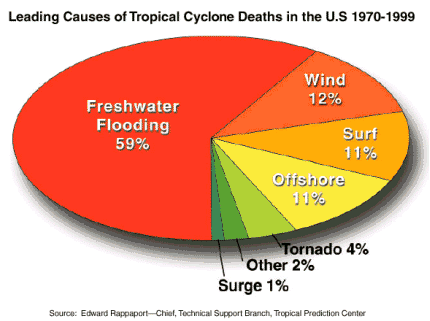Hint: It is tempting to attempt to drive through flooded areas only to be taken downstream by quickly moving water. There is one simple rule which is: If you cannot see the road or its line markings, do not drive through the water.
Preparing for Inland Flooding
Wind speeds from hurricanes are only part of the problem. Hurricanes also produce storms surges, tornadoes and perhaps the most deadly of all - inland flooding. Catastrophic flash flooding can occur following brief heavy rains and longer term flooding on rivers and streams can persist for several days after a storm. What you should do to be prepared for inland flooding includes:
- If a hurricane is coming ashore near you think inland flooding.
- Find out if you live in a zone that may potentially flood.
- Develop a flood emergency plan. This plan should comprehensively identify all of the steps you need to take before, during, and after a disaster to ensure maximum safety for you and your family as well as your property.
- Be aware of rising water and if advised to evacaute, do so immediately.
- Do not attempt to cross flowing water. Even a very small depth may cause you to slip or lose control of a vehicle.
- Have flood insurance. If your policy does not cover floods, check with the National Flood Insurance Program.
- Don't forget your pets!
Inland Flooding Video
Disaster Gear Checklist
Your basic disaster kit should include:
- Water - one gallon of water per person per day for at least 3 days
- Food - at least a three day supply of non-perishable food and can opener
- Batter powered or hand crank radio plus a NOAA Weather radio with extra batteries
- Flashlight or headlamp with extra batteries
- First aid kit
- Matches in a waterproof container
- Infant formula and diapers
- Pet food and water for your pet
- Whistle
- Cell phone with charger
- Prescription medications and glasses
- Cash or credit cards






